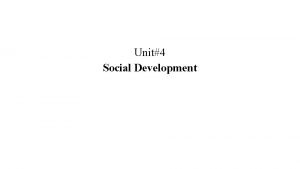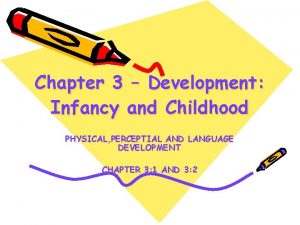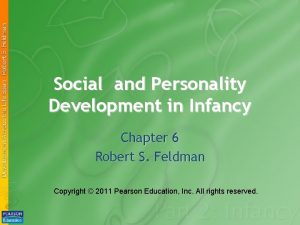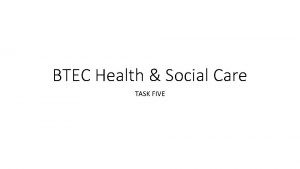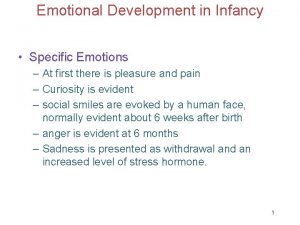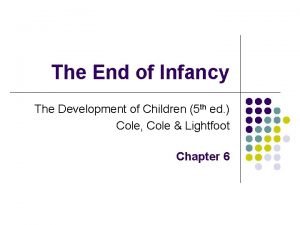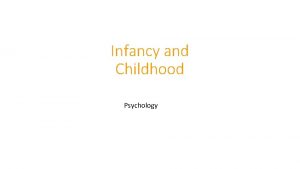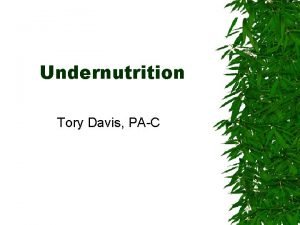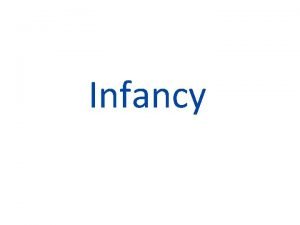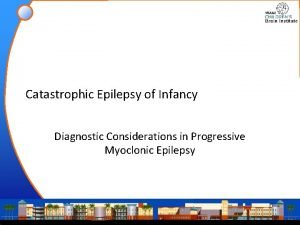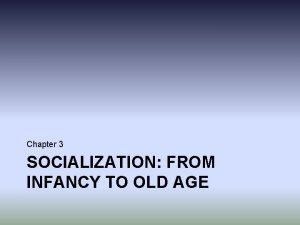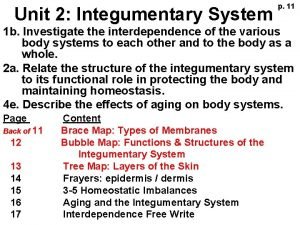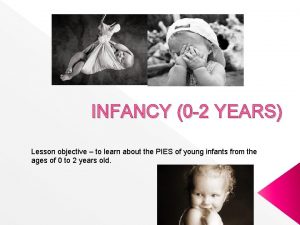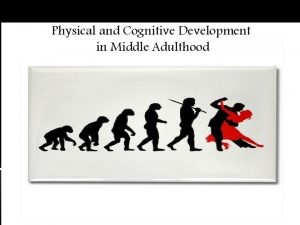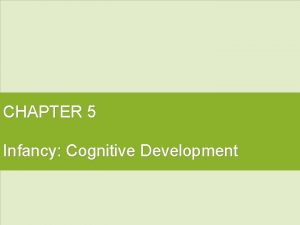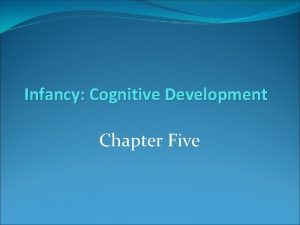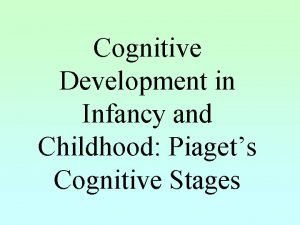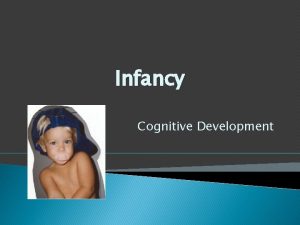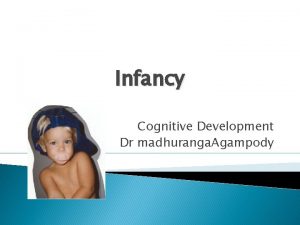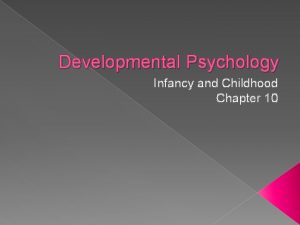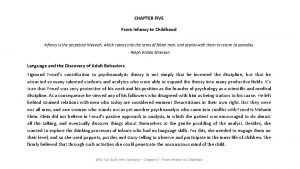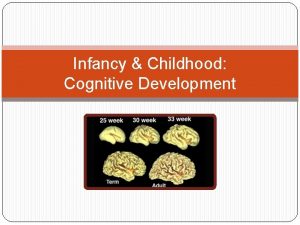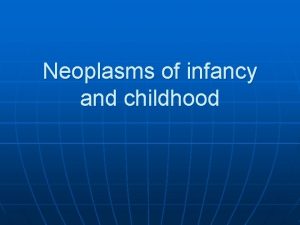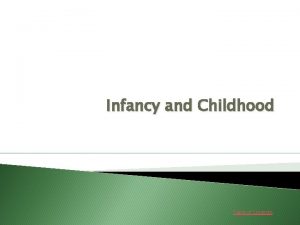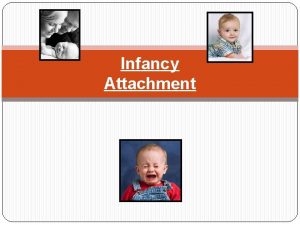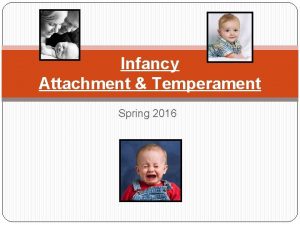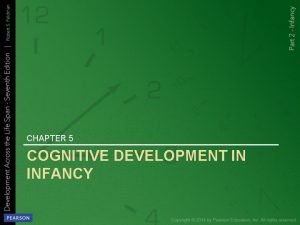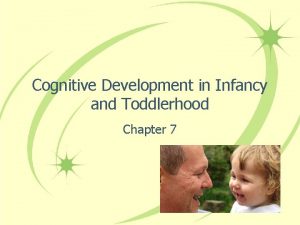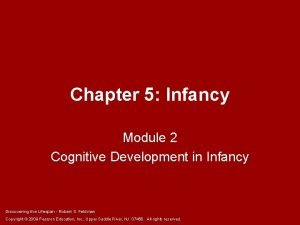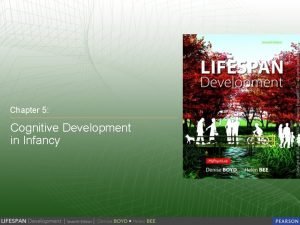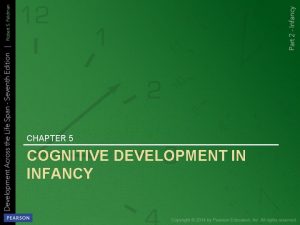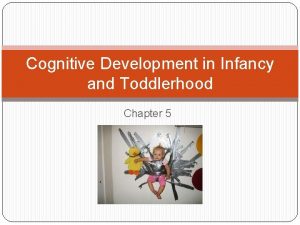Chapter 5 Infancy Cognitive Development What is Cognitive

































- Slides: 33

Chapter 5: Infancy: Cognitive Development

What is Cognitive Development? n The development of children’s ways of perceiving and mentally representing the world. Huh? Another way of saying “A focus on the developing thought processes of infants and children”

Question: n Who was the first theorist to focus on a child’s cognitive development? Piaget!

Piaget: n n n Studied children’s cognitive development as it progresses through 4 stages. He believed children were naturally curious. They want to make sense of their experiences, and in the process learn how to understand the world. He believed children were like scientists who create theories on how the world works. (and this makes life a little more predicable!)

Piaget’s Basic Principals: n n n Children’s cognitive development progresses in an orderly sequence of stages (which are invariant). Children’s concepts of the world are called Schemes are mental categories of related events, objects or knowledge.

Schemes, cont. n n Schemes are organized ways of making sense of experience that change with age. Schemes at first are action based, sensorimotor patterns repeated over and over; then later move to thinking before acting pattern which is more deliberate. Schemes change constantly, adapting to the children’s experiences. Children build schemes through direct interaction with the environment, called Adaptation

How Is This Adaptation (or change) Done? n n n Children attempt to Assimilate new events or experiences into existing schemes. When assimilation does not allow the child to make sense of novel events, they will Accommodate by modifying their existing schemes. Accommodation is when schemes are modified based on experience.

Adaptation, cont. n n When schemes are modified, the child organizes them. This organization creates an internal rearrangement and linking of schemes to create an interconnected system.

Review: n n We know that Piaget identified 4 stages of cognitive development. (remember them? ) In this chapter we will only focus on the first one, the Sensorimotor Stage.

Sensorimotor Stage of Development: n n n From birth to 2 years Involves learning through sensory and motor activities. Infants progress from responding to events with reflexes, to responding with goal-directed, intentional behavior that involves an awareness of past events.

What Characterizes Sensorimotor Thinking? n n n 1. Adapting to, and exploring the environment 2. Understanding objects 3. Using symbols

1. Adapting to and Exploring the Environment: n n n At first newborns respond reflexively to their environment. At about 8 months there is the onset of goal directed behavior there is a “means to an end. ” In this stage the infant gains the capacity to imitate/copy and action not originally in their repertoires. At 12 months infants become active experimenters, Behavior takes on a new experimental quality: Infants repeat actions over and over to see how they work like a “little scientist. ”

Trial and Error Learning: n The Little Scientist:

2. Understanding Objects: n n n Infants in the sensorimotor stage are beginning to understand objects. Objects: things which exist regardless of our actions and thoughts towards them. Early on for the infant it is “out of sight, out of mind. ”

What is Object Permanence? n n n The recognition that an object or person continues to exist when out of sight. Emerges over the 1 st yr. The development of object permanence is tied to the infants tendency to form mental representations (images) of an object and reason about them


3. Using Symbols: By 18 months infants have begun to talk and gesture, which is evidence of the use of symbols. n Symbols: represent objects and the relationships among them. * Remember: Words and gestures are symbols that stand for something else. n

3. Using Symbols, cont. n Wave bye-bye: same as saying “bye-bye” Apple: word represents the object Once infants begin using symbols they can begin to anticipate the consequences of actions mentally instead of having to perform them. Bye-Bye!

What is Information Processing? n n A focus on how children manipulate or process information coming in from the environment. What are the 2 tools that aid an infant in information processing? a. Memory b. Imitation

a. Memory: n n Memory improves dramatically between 2 -6 mo, then again by 12 mo. Memory improves as children age, which can be attributed to development in the parts of the brain responsible for memory.

b. Imitation: n Neonates have been found to imitate adults who open their mouth or stick out their tongue.

Imitation is Even Evident in…. n Infant Primates!

How Does Language Develop in Infants? n n It develops according to an invariant sequence of stages. At first infants vocalize using no words, called Prelinguistic Vocalizations. Prelinguistic vocalizations are sounds which do not represent objects or events. They are the steps to speech.

What are the Steps of Prelinguistic Vocalizations? n n n 1. Crying (Birth-1 mo) 2. Cooing (2 mo) Use of tongue to make noises of pleasure or excitement. Vowel like. “oooooh” and “ahhhh” 3. Babbling (6 -9 mo) First vocalizations that sound like human speech but have no meaning. “dah” “bah” “mah” Not screaming, babbling!

Steps in Prelinguistic Vocalizations, cont. n n 4. Echolalia (10 -12 mo) repetition of syllables over and over (bababa, dadada, pause then another combination. (sounds like conversation) 5. Intonation (end of 12 mo) Using the rising and falling melody of adult speech. Is sounding more like real speech because the infant stresses some syllables and varies their pitch.

What is Vocabulary Development? n n It refers to the child’s learning the meanings of words. Generally speaking, children’s receptive vocabulary develops faster than their expressive vocabulary. (this means that at any given time, they can understand more words than they can use)

What is Vocabulary Development? , cont. n n Receptive vocabulary: The ability to understand language. To make the link between speech sounds and particular objects. Expressive vocabulary: Ability to speak language.

A Child’s First Words: n n n Typically spoken between 11 -13 mo (range is from 8 mo-18 mo) tend to be 1 -2 syllables (mama, dada), animals, food, toys, and objects that move. 3 -4 mo after 1 st words, they develop 1030 words. By 18 mo, produce up to 50 words

A Child’s First Words, cont. n n n At 18 -22 mo there is a rapid burst in vocabulary. Increase from 50 to 300 words in a few months, mostly just nouns (called a “naming explosion”) This language growth continues until preschool. Children gain an average of 9 new words a day! By 2 ½ children have 275 -650 words.

Know: n The first words that children produce tend to be words their parents use frequently when they talk to them. This means…. . talk to you children!

Two Styles of Language Development: n n 1. Referential Language Style: Use of language to label objects in the environment. 2. Expressive Language Style: Use of language primarily as a means for engaging in social interactions. (this is more common)

Question: n What can a parent do (besides talking and reading to their child) to encourage their language development?

Need a Clue? Watch Sesame Street! Sesame Street, probably the most studied television program of all time, has been shown to have a variety of benefits for preschool children, including increases in vocabulary, ability to count, and general school readiness. Garrison, M. , Christakis, D. (2005).
 Chapter 5 cognitive development in infancy and toddlerhood
Chapter 5 cognitive development in infancy and toddlerhood Module 47 infancy and childhood cognitive development
Module 47 infancy and childhood cognitive development Module 47 infancy and childhood cognitive development
Module 47 infancy and childhood cognitive development Social development in infancy and childhood
Social development in infancy and childhood Socioemotional development in infancy
Socioemotional development in infancy Infancy psychosocial development
Infancy psychosocial development What are the stages of growth
What are the stages of growth Slidetodoc. com
Slidetodoc. com Internally programmed growth of a child
Internally programmed growth of a child Personality development in infancy
Personality development in infancy Personality development in infancy
Personality development in infancy Definition of intellectual in health and social care
Definition of intellectual in health and social care Emotional development in infancy
Emotional development in infancy Module 46 infancy and childhood physical development
Module 46 infancy and childhood physical development Chapter 10 infancy and childhood
Chapter 10 infancy and childhood Chapter 10 infancy and childhood
Chapter 10 infancy and childhood Chapter 10 infancy and childhood
Chapter 10 infancy and childhood Early childhood is __________ for language learning
Early childhood is __________ for language learning Cognitive and non cognitive religious language
Cognitive and non cognitive religious language Infancy period
Infancy period Infancy and childhood psychology
Infancy and childhood psychology Infancy early childhood middle childhood adolescence
Infancy early childhood middle childhood adolescence Infancy
Infancy Infancy physical changes
Infancy physical changes Catastrophic epilepsy infancy
Catastrophic epilepsy infancy Lesson quiz 3-2 infancy and childhood
Lesson quiz 3-2 infancy and childhood The cases of anna, isabelle, and genie
The cases of anna, isabelle, and genie Infancy childhood adolescence adulthood old age
Infancy childhood adolescence adulthood old age Pies in infancy
Pies in infancy Pavlik harness
Pavlik harness For adult
For adult Messianic prophecies fulfilled in the infancy narratives
Messianic prophecies fulfilled in the infancy narratives Intellectual development middle adulthood
Intellectual development middle adulthood Reflective and relativistic thinking
Reflective and relativistic thinking



